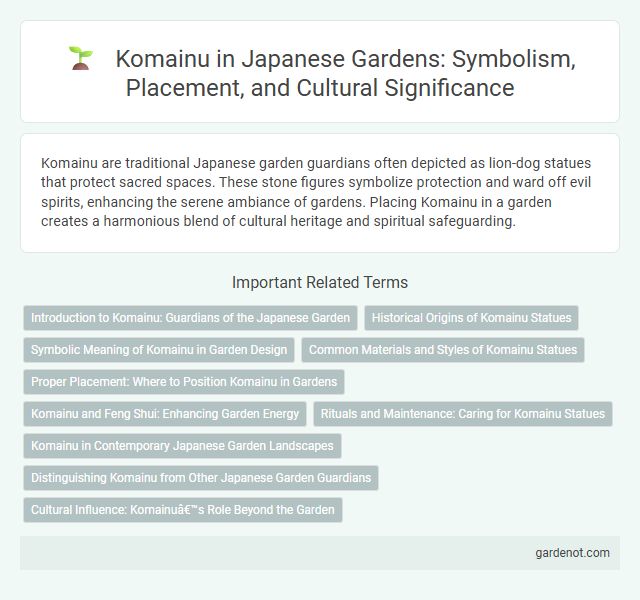Komainu are traditional Japanese garden guardians often depicted as lion-dog statues that protect sacred spaces. These stone figures symbolize protection and ward off evil spirits, enhancing the serene ambiance of gardens. Placing Komainu in a garden creates a harmonious blend of cultural heritage and spiritual safeguarding.
Introduction to Komainu: Guardians of the Japanese Garden
Komainu, often referred to as lion-dog statues, serve as protective guardians at the entrance of Japanese gardens and Shinto shrines. These mythical creatures symbolize strength and ward off evil spirits, embodying both spiritual and cultural significance in Japan. Positioned in pairs, the Komainu statues represent balance through their open and closed mouths, reflecting concepts of life and death.
Historical Origins of Komainu Statues
Komainu statues, often found at the entrances of Japanese Shinto shrines, originate from ancient guardian lion-dog figures introduced from China and Korea during the Nara period (710-794). These statues symbolize protection by warding off evil spirits and were adapted to align with indigenous Shinto beliefs and aesthetics. Their evolution reflects a blend of continental influences and Japanese cultural identity, marking a significant historical development in shrine architecture and religious practices.
Symbolic Meaning of Komainu in Garden Design
Komainu statues in Japanese gardens symbolize protection and spiritual guardianship, traditionally placed at entrances to ward off evil spirits. Their lion-dog imagery represents strength, courage, and balance, harmonizing with the garden's tranquil atmosphere. These figures embody cultural beliefs, enhancing the garden's role as a sacred, contemplative space.
Common Materials and Styles of Komainu Statues
Komainu statues in Japanese gardens are commonly crafted from granite, bronze, or ceramic, materials chosen for their durability and ability to withstand outdoor conditions. The most prevalent styles include the pair with one open-mouthed ("Agyo") symbolizing the beginning, and one closed-mouthed ("Ungyo") representing the end, reflecting ancient protective symbolism. Variations in posture and facial expressions are often influenced by regional artistic traditions and the specific shrine or garden's historical context.
Proper Placement: Where to Position Komainu in Gardens
Komainu are traditionally placed at the entrance of Japanese gardens or shrine gates to serve as protective guardians that ward off evil spirits. Positioning these lion-dog statues symmetrically on either side of pathways or bridges enhances both spiritual significance and visual balance. Proper placement respects cultural heritage while creating an inviting and harmonious atmosphere within the garden landscape.
Komainu and Feng Shui: Enhancing Garden Energy
Komainu statues in Japanese gardens act as spiritual guardians, channeling positive energy and blocking negative forces in alignment with Feng Shui principles. Their strategic placement near entrances maximizes the flow of chi, creating a harmonious and balanced environment. Incorporating Komainu enhances garden vitality by blending traditional symbolism with energy optimization techniques.
Rituals and Maintenance: Caring for Komainu Statues
Komainu statues, guardian lion-dogs in Japanese gardens, require regular ritual cleansing and seasonal maintenance to preserve their spiritual significance and physical integrity. Traditional practices include washing the statues with water during Shinto ceremonies to purify and renew their protective power. Maintenance involves inspecting for weathering, cleaning moss or debris, and occasionally applying protective coatings to prevent stone erosion caused by natural elements.
Komainu in Contemporary Japanese Garden Landscapes
Komainu, often seen as guardian lion-dog statues at the entrances of contemporary Japanese gardens, symbolize protection and ward off evil spirits. These intricately carved figures blend traditional aesthetics with modern garden design, enhancing spiritual ambiance and cultural authenticity. Their presence reinforces the harmonious balance between nature and mythology in contemporary Japanese garden landscapes.
Distinguishing Komainu from Other Japanese Garden Guardians
Komainu, often referred to as lion-dogs, are distinguished by their paired statues depicting one with an open mouth and the other with a closed mouth, symbolizing the beginning and end of all things. Unlike other Japanese garden guardians such as foxes (kitsune), which are linked to Inari shrines and specifically associated with rice and prosperity, Komainu serve as general protectors warding off evil spirits. Their unique stylized features and guardian role at Shinto shrine entrances set them apart from other mythical creatures commonly found in Japanese garden settings.
Cultural Influence: Komainu’s Role Beyond the Garden
Komainu, traditional lion-dog statues originating from Chinese guardian lions, serve as powerful symbols of protection and spiritual guardianship beyond the boundaries of Japanese gardens. These statues are commonly found at Shinto shrines and Buddhist temples across Japan, where they ward off evil spirits and safeguard sacred spaces. Their cultural influence extends into various aspects of Japanese art, folklore, and religious practices, embodying a fusion of aesthetic beauty and symbolic significance.
Komainu Infographic

 gardenot.com
gardenot.com